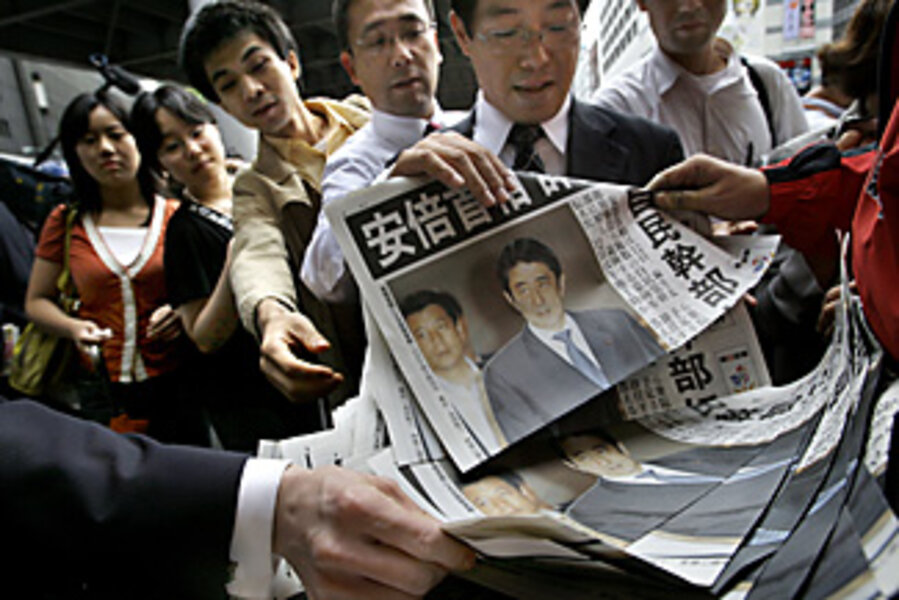Newspapers thriving? Yes – in Asia.
Loading...
| BANGKOK, THAILAND
Soaring circulation. Expanding newsrooms. A growing public hunger for, and appreciation of, a free media.
As the ailing US newspaper industry gasps for air, its counterparts in Asia are breathing in the exhilarating oxygen of success. Rising incomes and literacy levels – in an era of growing press freedom, democracy, and private media ownership – have lit a rocket under newsrooms across the region, say newspaper editors, industry analysts, and media executives.
Seven of the 10 best-selling daily newspapers are in Asia, which also has the three largest markets: China, India, and Japan, in that order. In 2006, circulation in Asia rose 3.6 percent, compared with a 2 percent fall in North America, according to the World Association of Newspapers. Since 1985, US newspaper sales have fallen more than 30 percent, the Audit Bureau of Circulations reported in 2006.
"The media has never been as powerful, or as pervasive, as it is in Asia right now," Shelia Coronel, director of the Stabile Center for Investigative Journalism at Columbia University, told a media conference this week organized by the East-West Center, a US government-supported research center in Hawaii.
It's also profitable: Advertisers in Asia are spending more to reach consumers in booming urban centers with rising incomes and education levels. In India, newspaper advertising revenues rose 85 percent between 2001 and 2006 on the back of a 54-percent increase in circulation.
Editors say the rise of digital media is starting to hurt newspaper revenues in mature markets such as Taiwan and South Korea, where younger readers are moving online and want livelier content. Mainstream media are also challenged by bloggers and citizen journalists in countries such as Burma (Myanmar), where state-run media are distrusted, and Malaysia, where private media groups are aligned with political parties.
But elsewhere, the spread of the Internet, e-mail, and cable TV has boosted public demand for news. "Over the last five years, with the broadcast media opening up and doing live broadcasts, the appetite for news has increased tremendously," says Kamal Siddiqi, an editor at The News, an English-language daily in Pakistan. He estimates that more than 100 evening newspapers are published in Karachi alone, with many new titles appearing.
A similar flurry of new publications, as well as the revival of shuttered titles, followed Indonesia's 1998 restoration of democracy. After decades of censorship, Indonesia's press now ranks among the region's freest.
Still, having escaped government shackles, news outlets in young democracies are also grappling with marketplace demands. As the field gets more crowded, and cable news and online sites create a faster news cycle, some newspaper proprietors push celebrity stories over serious news, say editors.
India's rapid media expansion since 2001 has coincided with a shift by some broadsheet newspapers to more "feel-good" news and cricket coverage, says Nanda Banerjee, a consulting editor for the Indian Press Agency. "The serious part of journalism is taking a back seat. The entertainment journalism is at the front," he says.
Chinese newspapers face different challenges, such as state censors. China boasts the highest number of newspapers sold (99 million daily in 2006) but also the most journalists in jail (31 at the end of 2006), the Committee to Protect Journalists reports. Publications that offend can be closed down. Censorship is pervasive on the Internet.
The picture in China isn't totally gloomy, says Ms. Coronel, a reporter from the Philippines. By cutting subsidies to state-owned newspapers, China has forced them to compete for readers. This has created an appetite for scoops and bolder reporting. "Chinese media is doing more original and investigative reporting. The market does create opportunities for watchdog journalism, as it did in early-20th-century America," says Coronel.
Citizen journalism is growing rapidly in South Korea, among the world's most wired countries. Ohmynews is a prominent website that draws on the reporting of 40,000 journalists and generates enough advertising to turn a profit, says Ryong Oh of the Asia Journalist Association, a nonprofit in Seoul. One reason South Koreans are turning to Ohmynews is that the country's three dominant newspapers are politically timid, says Mr. Oh. "As the government changes, they change their positions. People distrust these newspapers, so they search for new media sources." Still, newspaper circulation in South Korea rose 19 percent between 2001 and 2006.
Perhaps the biggest surprise in Asia is Japan's enduring newspaper culture. Circulation has declined in recent years, but Japanese remain the world's leading per-capita consumers of newsprint. Ownership rules in Japan shield newspapers from shareholder pressure, allowing them to invest in the newsroom, says Orville Schell, former dean of the Graduate School of Journalism at the University of California. This contrasts with US newspaper groups that face cutbacks if they don't meet growth targets.
But, as in the US, the writing may be on the wall for Japanese news outlets without an online strategy, says Hisayoshi Ina, vice chairman of the editorial board at Nikkei, a newspaper. "The younger generation don't have the habit to read the newspaper. They prefer the Internet to paper," he says.





